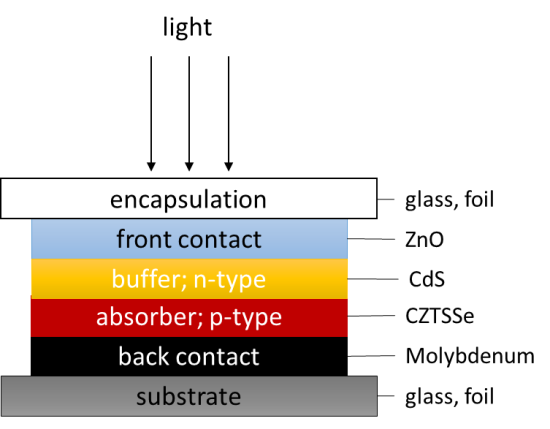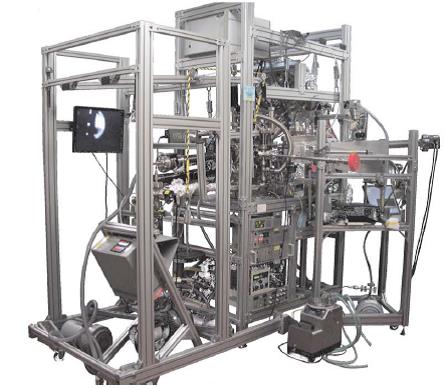FREE-INCA
FREE-INCA is a BMBF (German Federal Ministry for Education and Research) funded project, the goal of which is the development and optimization of CuZnSn(S,Se)2 kesterite-based thin-film solar cells.
|
Kesterite-based solar cells are composed of earth-abundant materials, which make them a promising candidate for low-cost thin-film solar cells. However, the efficiency of kesterite-based solar cells is significantly lower than of other thin-film solar technologies. One culprit for the low efficiency is the high open-circuit voltage deficit, which limits the overall efficiency of this type of thin-film solar cells. Within the Free-InCa project, different preparation techniques and cell setups are evaluated together with high-level characterization techniques, to achieve an insight-driven improvement of the solar cell performance. |
|
A particular focus of these investigations are the interfaces within the solar cell. At the IPS and ITCP, the electronic and chemical structure at these interfaces (e.g., the absorber/buffer interface) are investigated. For this purpose, laboratory-based spectroscopy techniques, namely x-ray photoelectron spectroscopy (XPS), ultraviolet photoelectron spectroscopy, and inverse photoemission spectroscopy (IPES), as well as X-ray-excited Auger electron spectroscopy are utilized.
|
In addition, synchrotron-based soft x-ray spectroscopies (x-ray absorption (XAS), x-ray emission spectroscopy (XES), and resonant inelastic x-ray scattering (RIXS)) are used at the synchrotron light source at KIT and the Advanced Light Source, Lawrence Berkeley National Laboratory, USA. In Fig. 2, the measurement setup at the ALS is exemplarily shown. |
|
Project partners
- University of Oldenburg
- Zentrum für Sonnenenergie- und Wasserstoffforschung Baden-Württemberg (ZSW)
- Lichttechnisches Institut, KIT
Contact information: Dr. Dirk Hauschild, dirk hauschild ∂does-not-exist.kit edu
FREE-INCA is funded by the BMBF under the project no.: 03SF0530A/B/C
Literature
- Chemical Structure of a Carbon-Rich Layer at the Wet-Chemical Processed Cu2ZnSn(S,Se)4/Mo Interface, Hauschild, D.; Wachs, S. J.; Kogler, W.; Seitz, L.; Carter, J.; Schnabel, T.; Krause, B.; Blum, M.; Yang, W.; Ahlswede, E.; Heske, C.; Weinhardt, L., 2021. IEEE Journal of Photovoltaics, doi:10.1109/JPHOTOV.2021.3059423
- Intermixing at the InxSy/Cu2ZnSn(S,Se)4 Heterojunction and Its Impact on the Chemical and Electronic Interface Structure, Hauschild, D.; Mezher, M.; Schnabel, T.; Spiering, S.; Kogler, W.; Carter, J.; Blum, M.; Yang, W.; Ahlswede, E.; Heske, C.; Weinhardt, L., 2019. ACS applied energy materials, 2 (6), 4098–4104. doi:10.1021/acsaem.9b00263
- Hybrid chemical bath deposition-CdS/sputter-Zn(O,S) alternative buffer for Cu2ZnSn(S,Se)4 based solar cells editors-pick, Kogler, W.; Schnabel, T.; Ahlswede, E.; Taskesen, T.; Gütay, L.; Hauschild, D.; Weinhardt, L.; Heske, C.; Seeger, J.; Hetterich, M.; Powalla, M., 2020. Journal of applied physics, 127 (16), 165301. doi:10.1063/1.5142550
- M. Bär, B.-A. Schubert, B. Marsen, R.G. Wilks, M. Blum, S. Krause, S. Pookpanratana, Y. Zhang, T. Unold, W. Yang, L. Weinhardt, C. Heske, and H.-W. Schock, J. Mater. Res. 27, 1097 – 1104 (2012).
- M. Bär, B.-A. Schubert, B. Marsen, S. Krause, S. Pookpanratana, T. Unold, L. Weinhardt, C. Heske, and H.-W. Schock, Appl. Phys. Lett. 99, 152111 (2011).


